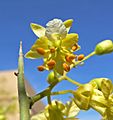Yellow paloverde facts for kids
Quick facts for kids Yellow paloverde |
|
|---|---|
 |
|
| Scientific classification | |
| Kingdom: | |
| (unranked): | |
| (unranked): | |
| (unranked): | |
| Order: | |
| Family: | |
| Subfamily: | |
| Tribe: |
Caesalpinieae
|
| Genus: |
Parkinsonia
|
| Species: |
P. microphylla
|
| Binomial name | |
| Parkinsonia microphylla Torr.
|
|
 |
|
| Natural range | |
| Synonyms | |
|
Cercidium microphyllum (Torr.) Rose & I.M. Johnst. |
|
The Yellow Paloverde (scientific name: Parkinsonia microphylla) is a special tree found in the deserts. It's also known as the Foothill Paloverde or Little-leaved Palo Verde. This tree grows naturally in the southwestern parts of the United States, like southeastern California and southern Arizona. You can also find it in northwest Mexico, in places like Sinaloa, Sonora, and Baja California. It loves to grow on hillsides and is one of the most common trees in the Sonoran Desert.
What Does the Yellow Paloverde Look Like?
The Yellow Paloverde is a tree with many branches that grow upwards. It grows very slowly and can live for hundreds of years. Most Yellow Paloverde trees grow to be about 5 meters (16 feet) tall. Sometimes, they can even reach 6 or 7 meters (20 to 23 feet) in height.
Leaves and Photosynthesis
The leaves of this tree are a yellowish-green color. When the weather is very dry and hot, the tree will drop its leaves. But don't worry, it has a special way to survive! The bark of the Yellow Paloverde is green, and it can do photosynthesis. Photosynthesis is how plants make their own food using sunlight, water, and air. Because its bark can do this, the tree can stay alive even when it has no leaves during hot, dry times.
Flowers and Seeds
Small, pale yellow flowers grow at the ends of the branches in late spring. The tree might not flower every year. It depends on how much rain there has been. If there's enough rain, the tree will also grow seeds. These seeds are found in soft pods that are about 4 to 8 centimeters (1.5 to 3 inches) long. The pods have dips between each seed. The seeds become ready in July and stay attached to the branches.
Young Paloverde plants are very sensitive to dry weather when they are tiny. For the first two to three months, they need a lot of water. Only about 1.6% of the seeds that sprout will survive.
Threats to Young Paloverde Trees
One challenge for young Yellow Paloverde trees is a type of grass called Buffelgrass. This grass comes from Africa and was brought to the Sonoran Desert for farm animals to eat. Buffelgrass spreads very quickly. It can take away the water that young Paloverde plants need to grow. This could be a problem for the future of the Yellow Paloverde.
How Yellow Paloverde Helps Nature
The Yellow Paloverde is a great plant for honeybees. Its small branches are also eaten by wild animals, like jackrabbits. If there isn't much food around, farm animals might also nibble on it. Small animals like rodents often carry the seeds and bury them underground. Some of these buried seeds will then sprout after it rains.
Ways People Use the Yellow Paloverde
The Seri people, a Native American group from northwest Mexico, call this tree ziipxöl. They used to use the Yellow Paloverde in many ways:
- They would grind the seeds into flour to make food.
- They boiled the green pods with meat.
- They ate the sweet green seeds and the flowers.
- They even made necklaces by stringing the seeds together.
Growing Yellow Paloverde in Gardens
The Yellow Paloverde is also grown as an ornamental tree. This means people plant it because it looks nice. It's popular in gardens that use less water (called xeriscapic gardens) and in gardens that feature native plants. You might also see it planted as a small tree in parking lots of stores and businesses.
Gallery
-
Saguaro and Palo Verde forest, Ironwood Forest National Monument
See also
 In Spanish: Paloverde amarillo para niños
In Spanish: Paloverde amarillo para niños




